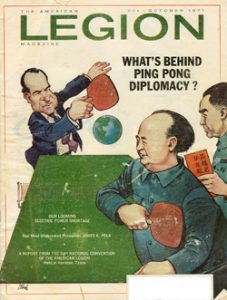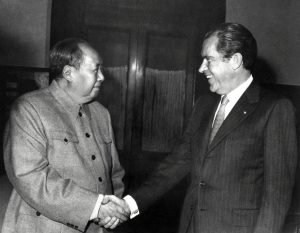INTRODUCTION
Part 2 of a 5 Part Series
This series begins with Trump at the UN: Part 1, a Tale of Two Presidents and a Vision
 In 1971, for all practical purposes, China was closed to the world. There were import/export restrictions in place and China’s access to world currency markets, particularly US dollars was virtually non-existent. President Nixon had made opening up relations with China a priority and his administration began working on it when he assumed office. Then came “ping pong diplomacy”. After an inadvertent meeting of Chinese and American ping pong players during the 1971 World Table Tennis Championships in Nagoya, Japan, Communist Party Chairman Mao Zedong invited the American team to Beijing.
In 1971, for all practical purposes, China was closed to the world. There were import/export restrictions in place and China’s access to world currency markets, particularly US dollars was virtually non-existent. President Nixon had made opening up relations with China a priority and his administration began working on it when he assumed office. Then came “ping pong diplomacy”. After an inadvertent meeting of Chinese and American ping pong players during the 1971 World Table Tennis Championships in Nagoya, Japan, Communist Party Chairman Mao Zedong invited the American team to Beijing.
On April 10, 1971, the Americans crossed a bridge from Hong Kong into China. During their ten day stay they were treated like dignitaries. During the visit team President Graham Steenhoven noticed that a “Welcome American Team” banner had been hung over a wall painted with the words “Down With the Yankee Oppressors and Their Running Dogs!” There was a message in Steenhoven’s observation that has been ignored in the nearly five decades since, the facade of Chinese friendship covering real intentions.
 Two months later Nixon’s National Security Adviser Henry Kissinger made secret trip to the then all but closed world of “Red” China. Kissinger carried the hope that integrating China into the world economy would have beneficial effects for the world and the Chinese people. President Nixon went to Beijing in February, 1972 and China’s integration into the world economy began.
Two months later Nixon’s National Security Adviser Henry Kissinger made secret trip to the then all but closed world of “Red” China. Kissinger carried the hope that integrating China into the world economy would have beneficial effects for the world and the Chinese people. President Nixon went to Beijing in February, 1972 and China’s integration into the world economy began.
Over the nearly 50 years since, the result has been a China taking advantage of its people to produce products in conditions and at wages that would not be countenanced in a Western democracy. The Chinese have dangled a false market of a billion consumers to entice Western companies and countries to share technology and intellectual property which is then stolen. All this is done to secure the power of the Communist Party elite.
President Trump sees the reality of China rather than the false potential that has lured businesses and politicians over the last five decades. Trump, even as a private citizen, knew that China cheats as a competitor without any intent of being a legitimate partner. In Part 2 of his talk at the United Nations on September 24, 2019, he addressed the realities of China, including Hong Kong. Trump has long understood Chinese intent behind “Welcome American Team”.
Trump at the UN:
Part 2, China
PRESIDENT TRUMP: The most important difference in America’s new approach on trade concerns our relationship with China. In 2001, China was admitted to the World Trade Organization. Our leaders then argued that this decision would compel China to liberalize its economy and strengthen protections to provide things that were unacceptable to us, and for private property and for the rule of law. Two decades later, this theory has been tested and proven completely wrong.
Not only has China declined to adopt promised reforms, it has embraced an economic model dependent on massive market barriers, heavy state subsidies, currency manipulation, product dumping, forced technology transfers, and the theft of intellectual property and also trade secrets on a grand scale.
As just one example, I recently met the CEO of a terrific American company, Micron Technology, at the White House. Micron produces memory chips used in countless electronics. To advance the Chinese government’s five-year economic plan, a company owned by the Chinese state allegedly stole Micron’s designs, valued at up to $8.7 billion. Soon, the Chinese company obtains patents for nearly an identical product, and Micron was banned from selling its own goods in China. But we are seeking justice.
The United States lost 60,000 factories after China entered the WTO. This is happening to other countries all over the globe.
The World Trade Organization needs drastic change. The second-largest economy in the world should not be permitted to declare itself a “developing country” in order to game the system at others’ expense.
For years, these abuses were tolerated, ignored, or even encouraged. Globalism exerted a religious pull over past leaders, causing them to ignore their own national interests.
But as far as America is concerned, those days are over. To confront these unfair practices, I placed massive tariffs on more than $500 billion worth of Chinese-made goods. Already, as a result of these tariffs, supply chains are relocating back to America and to other nations, and billions of dollars are being paid to our Treasury.
The American people are absolutely committed to restoring balance to our relationship with China. Hopefully, we can reach an agreement that would be beneficial for both countries. But as I have made very clear, I will not accept a bad deal for the American people.
As we endeavor to stabilize our relationship, we’re also carefully monitoring the situation in Hong Kong. The world fully expects that the Chinese government will honor its binding treaty, made with the British and registered with the United Nations, in which China commits to protect Hong Kong’s freedom, legal system, and democratic ways of life. How China chooses to handle the situation will say a great deal about its role in the world in the future. We are all counting on President Xi as a great leader.
The United States does not seek conflict with any other nation. We desire peace, cooperation, and mutual gain with all. But I will never fail to defend America’s interests.
This series begins with Trump at the UN: Part 1
It continues with Trump at the UN: Part 3






[…] President Trump’s speech continues with Trump at the UN: Part 2, China […]